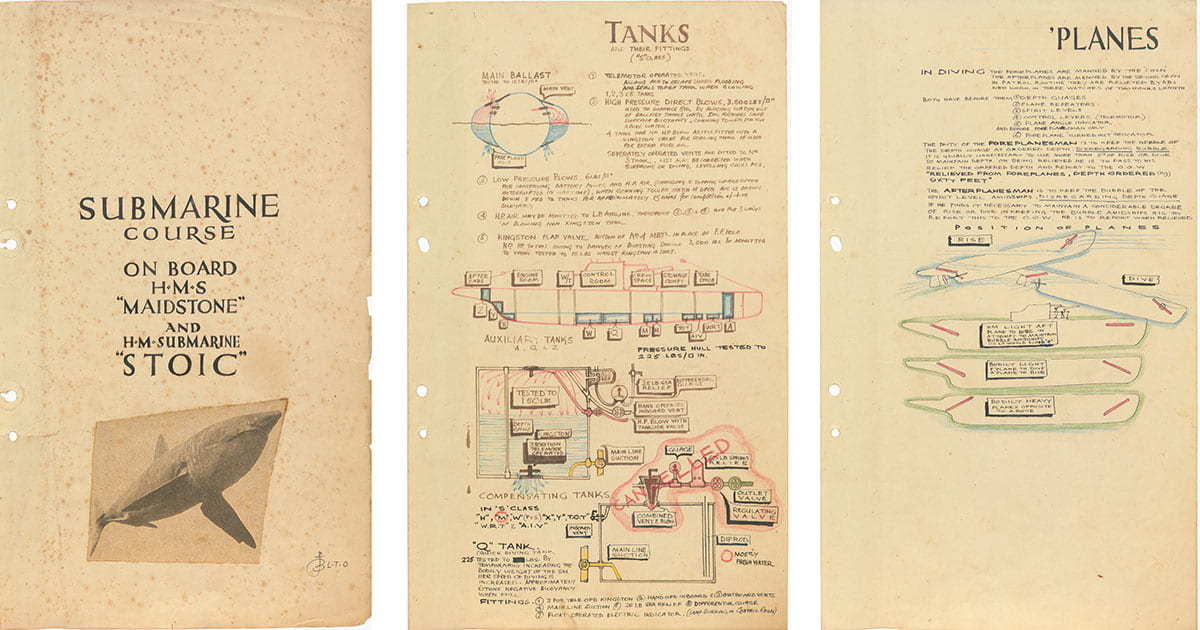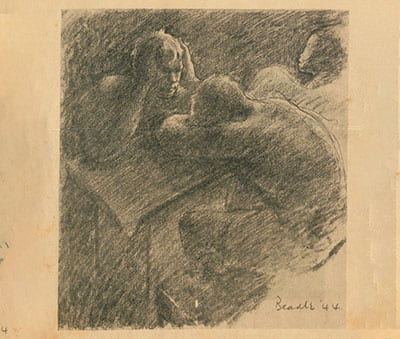To mark this year’s 20th anniversary of Special Collections, the curators have selected some intriguing items for the Twenty at 20 series. Here is number 18.
Delving beneath the waves
Paul Beadle is probably best known as an influential sculptor, artist and the first Professor of the Elam School of Fine Art. What may be less well known is that he served with the Royal Navy during the Second World War as a submariner and navy artist.

From left – Image 1: Front cover, Submarine course manual; image 2: Controlling the dive: Water compensation tanks; Image 3: Dive, dive, dive.
Beadle’s naval service included several tours on board the submarine depot ship HMS Maidstone and the submarines HM Sea Rover and HM Sturdy. The Maidstone’s purpose was to re-supply and refit the submarine fleet operating in the Mediterranean and Far East. It was during his time aboard the Maidstone that Beadle illustrated the manual Submarine course on Board H.M.S. “Maidstone” and H.M. Submarine “Stoic.”1 This document contains more than two dozen hand-coloured illustrations showing the inner workings of a submarine, including engine schematics, electrics, ballast tanks, and the vessel’s internal structure. The manual’s cover carries Beadle’s monogram signature in the bottom-right corner, and he placed several small doodles and other drawings throughout the document.
“It’s only a tin full of people”2
Submarines have both fascinated and terrified me since my brief stint in the New Zealand Navy, and later, with the Western Australian Maritime Museum, which had its own Cold War-era submarine. The design of the submarine has certainly changed since the Dutch inventor Cornelis Drebbel reportedly developed the world’s first navigable submarine in 1620.3 They are formidable fighting machines – something Leonardo da Vinci recognised in the 1500s after he designed his own underwater vessel. However, while their complicated engineering kept the crew both alive and hidden while submerged, they were still highly vulnerable to attack. Indeed, the Royal Navy submarine service suffered heavy losses during the Second World War. Being confined in a metal tube beneath the waves must have been a terrifying ordeal, especially when being hunted by warships above. Beadle captured some of this anxiety in this sketch of his crew mates on board HM submarine Sturdy during a depth charge attack.4
Leaving the service behind
Beadle (1917-1992) was discharged from the Navy at the end of the war in 1945, and lived in Sydney, Australia. Through the 1950s he worked as a freelance sculptor, illustrator and art teacher. In 1961 he was appointed as the foundation Chair of Fine Arts at the University of Auckland. Until 1975 he was the Dean of Elam School of Art. While at Elam, Beadle developed an interest in bronze casting and numismatics. While he was known for his complex human figures, he also undertook several commissions for the Government Treasury including the 1974 the Commonwealth Games medal and the reverse side of the commemorative one-dollar coin for the 1981 visit by Queen Elizabeth II.
Nigel Bond, Special Collections


